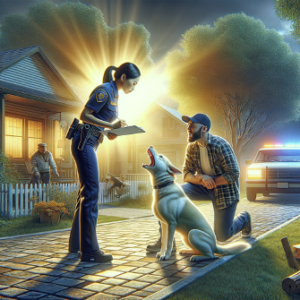The Rights of Pet Owners in Animal Control Situations
Understanding Pet Owner Rights in Animal Control Situations
As a devoted pet owner, you cherish the bond you share with your furry friends. However, navigating the complexities of local laws and regulations concerning animal control can sometimes feel overwhelming. It’s crucial to be informed about your rights as a pet owner, especially in situations where your pet’s well-being may be at stake. Let’s explore the fundamental rights that pet owners possess and the legal protections available to ensure those rights are upheld.
Your Rights as a Pet Owner
- Right to Fair Treatment:
Every pet owner has the right to fair treatment by animal control officials. This includes proper notification before any action is taken against your pet, whether it’s a warning regarding noise complaints or an investigation into potential neglect. Authorities must adhere to established protocols, ensuring that any decisions regarding your pet are based on valid evidence rather than hearsay. - Right to Access Information:
As a pet owner, you have the right to access information about local animal control laws and regulations. This includes knowing the ordinances that govern pet ownership in your area, such as pet licensing, leash laws, and nuisance regulations. Understanding these rules helps you stay compliant and protects you against potential fines or legal issues. - Right to a Hearing:
If animal control has seized your pet or threatens to do so, you have the right to challenge their decision. Most jurisdictions provide pet owners with an opportunity to appeal, which typically includes a formal hearing where you can present evidence and argue your case. This right is fundamental in ensuring that your side of the story is heard.
The Legal Framework Protecting Your Rights
The protection of pet owner rights largely stems from local and state animal welfare laws. These laws are designed to ensure humane treatment of animals while balancing community safety. Familiarize yourself with these regulations, as they vary by state and locality. Consulting with an attorney specializing in animal law can bolster your understanding and advocacy in situations that test your rights as a pet owner.
Tips for Protecting Your Rights
- Stay Informed: Keep yourself updated on local animal control regulations. Your city or county’s website usually has detailed guidelines related to pet ownership.
- Document Everything: Activity logs, photographs, and copies of communications with animal control agencies can be valuable if you need to defend your rights.
- Engage with Community Groups: Joining local pet owner or animal rights groups can provide support and resources that bolster your knowledge.
Conclusion
Understanding your rights as a pet owner is not just about protecting your beloved companion; it’s about ensuring your relationship with them remains strong and free from unnecessary legal entanglements. Stay informed, document key interactions, and remember that you have a voice. If you ever find yourself in a challenging animal control situation, knowing your legal rights can empower you to take action.

Responsibilities of Pet Owners
As much as we adore our pets and consider them part of our families, being a responsible pet owner requires more than just love. There are specific obligations that come with pet ownership, particularly pertaining to local laws designed to ensure the well-being of animals and the safety of the community. Understanding these responsibilities can empower you to be a conscientious pet owner, while also avoiding potential legal troubles.
- Licensing Your Pet:
Most municipalities require pets to be licensed. This means registering your pet with local authorities, typically for a small fee. Licensing ensures that your pet is accounted for in the event they go missing and helps authorities track vaccination compliance. Failure to license your pet may result in fines or penalties. Check with your local animal control agency or city hall for specific licensing requirements, including rabies vaccination proof, which often goes hand in hand with the registration process. - Vaccination Compliance:
Vaccinations are vital not only for your pet’s health but also for public safety. Common vaccinations include rabies, distemper, and parvovirus, among others. Many local laws mandate that pets have a rabies vaccination, and proof must often be provided during licensing. Keeping your pet’s vaccinations up to date not only protects them from harmful diseases but also safeguards other animals and people in your community. Be proactive—schedule routine veterinary check-ups to ensure compliance and maintain your pet’s health. - Keeping Pets Restrained:
One of the most critical responsibilities of a pet owner is ensuring that pets are kept restrained, whether in public spaces or at home. Most local laws require dogs to be on leashes when off your property, while cats are best kept indoors to prevent them from straying or becoming a nuisance. This restraint protects your pet from potential harm and helps prevent accidents. Violating leash laws can lead to fines and serious safety issues, both for your pet and others. Consider investing in a quality leash and harness to keep your furry friend safe during outings. - Providing a Safe Environment:
In addition to following local laws, pet owners have a duty to provide a safe and loving environment for their pets. This includes proper shelter, nutrition, and socialization. Taking care of these fundamental needs not only adheres to animal welfare standards but also creates happier pets. Regular grooming and attention to any behavioral issues are equally essential, as a well-cared-for pet is less likely to cause problems within the community. - Clean Up After Your Pet:
Responsible pet ownership extends to cleanliness. Most communities have ordinances requiring pet owners to clean up after their pets in public areas. Carrying waste bags on walks and disposing of waste properly not only shows respect for your neighbors but also helps keep your community safe and clean.
Conclusion
Understanding and adhering to these responsibilities—such as pet licensing, vaccinations, restraint, and providing a safe environment—will not only keep you compliant with local laws but also nurture a positive pet-owner relationship. Responsible pet ownership ensures that both your beloved companion and community members can coexist happily and healthily.

How Animal Control Agencies Operate
Now that you have an understanding of your rights as a pet owner, it’s essential to delve into how animal control agencies operate in addressing complaints or incidents involving pets. Understanding their procedures and regulations not only informs you as a pet owner but can also equip you with the knowledge to handle situations more effectively if you encounter them.
The Chain of Events in Animal Control Procedures
**1. *Receiving Complaints:* When a complaint regarding an animal is lodged, animal control agencies usually initiate their process with an evaluation of the report. Complaints can vary significantly—from stray animals to noise disturbances or reports of neglect and abuse. For example, a neighbor might call in because a dog has been barking incessantly. The agency document these complaints and prioritize them based on urgency and severity.
- Initial Assessment: After a complaint is received, animal control officers conduct an assessment of the situation. This can involve a visit to the location to observe the animal in question and gather pertinent information. In many cases, the officer will attempt to contact the pet owner to gain insight into the situation. If we take the barking dog scenario, an officer might discuss the issue with the dog’s owner, finding that the barking is a reaction to unfamiliar noises, and suggest proactive measures to alleviate the concern.
- Investigation: If the initial assessment reveals potentially serious violations, such as neglect or presence of unlicensed animals, a formal investigation may begin. This could involve gathering evidence, taking photographs, and even speaking to witnesses. For instance, if a pet owner is reported for abandoning their pets, the agency would need to collect evidence to support their findings before proceeding with any enforcement action.
- Enforcement Action: Based on the evidence gathered, animal control agencies have the authority to take appropriate enforcement action. This can range from issuing warnings to seizing animals in extreme cases of neglect. A real-life example includes a situation where an animal control agency intervened in a case of overbreeding and hoarding. After accumulating sufficient evidence, they executed a seizure of the animals to ensure their well-being, while also following legal protocols to safeguard the rights of the owner.
- Resolution and Follow-Up: After resolving an issue, animal control agencies often provide resources for pet owners. This may involve referrals to local animal welfare organizations, information on proper pet care, or assistance in resolving disputes with neighbors. Following up on cases, particularly those involving seized animals, ensures compliance with adoption agencies or rehabilitation programs to find the animals loving homes.
What Pet Owners Should Know
- Understand Local Regulations: Each locality has specific animal control laws. Familiarizing yourself with these can prevent misunderstandings. Your city or county’s website will likely have details on licensing and reporting procedures.
- Be Proactive: If you suspect your pet might become the subject of a complaint, address concerns before they escalate. This could involve engaging with your neighbors to discuss any issues.
- Document Incidents: If you feel your pet is unfairly targeted, keep records of communications and events. This documentation can be valuable if you need to defend your position.
By understanding how animal control agencies operate, you can better navigate any interactions that may arise regarding your pet. Awareness of procedures helps ensure you can engage effectively and advocate for your rights as a responsible pet owner.

The Process of Disputing Animal Control Decisions
Even the most responsible pet owners can encounter disputes with animal control agencies. If you believe your rights have been violated or decisions made against your pet are unfair, it’s crucial to act swiftly and effectively. Here’s a comprehensive, step-by-step guide on how to navigate this process, emphasizing the importance of documentation and communication.
Document Everything
Before you even think about disputing any decisions, ensure that you have a detailed account of all relevant interactions with animal control. This documentation can be your strongest ally in any appeal process. Here are some tips:
- Maintain an Activity Log: Keep a chronological record of all events related to your case. This includes dates, times, locations, and nature of the incidents.
- Gather Evidence: Take photographs or videos that support your case. This could include images of your pet, your living environment, or any signs of the alleged issues (like noise complaints).
- Collect Correspondence: Retain copies of all communications with animal control, including emails, letters, and notes from phone conversations. Always note the names of the individuals you spoke with and the date of those conversations.
Effective Communication
Once you have your documentation in place, the next step involves clear and respectful communication. Here’s how to navigate conversations with animal control officials:
- Reach Out Promptly: As soon as you receive notification of the decision, contact the animal control office. The sooner you address the issue, the better.
- Be Calm and Professional: Regardless of how emotional the situation may be, approaching animal control with a level head can facilitate a more productive dialogue. Present your case clearly and avoid confrontation.
- Request Specifics: Politely ask for detailed explanations regarding the actions taken against you or your pet. This not only shows your willingness to understand the situation but may also reveal potential misunderstandings that can be rectified.
Appealing the Decision
If you believe that you have a valid case against the animal control decision, initiating an appeal is your next step. Here’s what you need to do:
- Understand the Appeal Process: Each jurisdiction has its own procedure for appeals. Check local laws or the animal control agency’s website to know the specific steps you must follow.
- Prepare Your Case: Using your collected evidence and documentation, create a clear argument that supports your position. Make sure to address the specific concerns raised by animal control.
- Request a Hearing: In most instances, you can formally request a hearing to present your case. Be sure to follow any required formats and deadlines to ensure your appeal is heard.
Know Your Rights During This Process
Throughout this dispute, keep your rights as a pet owner at the forefront. Familiarize yourself with:
- Local Regulations: As previously mentioned, understanding local ordinances can inform your appeal and help you advocate effectively.
- Right to Representation: While navigating this process, consider involving an attorney who specializes in animal law. They can provide valuable insights and additional support during hearings.
- Community Support: Engage with local pet owner groups or animal rights organizations that can offer guidance and advice based on their experiences.
Conclusion
Successfully disputing animal control decisions requires diligence, documentation, and effective communication. By staying organized and informed, you can navigate this challenging process and assert your rights as a responsible pet owner.

Navigating the Appeals Process
If you find yourself in a situation where actions taken by local animal control officials threaten your pet’s well-being, understanding how to navigate the appeals process is vital. This guide will walk you through the steps of appealing any adverse decisions regarding your pet while emphasizing the importance of seeking legal advice and comprehending local ordinances.
Key Steps in Navigating the Appeals Process
- Review the Notice of Action:
When you receive a notice from animal control about any action regarding your pet, whether it’s a citation, a seizure, or other enforcement actions, carefully read the entire document. Not only will this provide you with essential information about the decision, but it will also outline the specific timeline and procedures for filing an appeal. Usually, there’s a designated time frame (often within a few days) for you to respond or file your appeal, so make note of these critical details. - Gather Relevant Documentation:
Before beginning the appeals process, collect all necessary documents that support your case. This includes:
- Photographs of your pet and their living environment
- Written correspondence with animal control
- Records of any relevant veterinary care or pet training
- Witness statements from friends, neighbors, or community members who can testify on your behalf
Having comprehensive documentation can strengthen your position and provide a clear narrative regarding your pet’s situation.
- Seek Legal Advice:
Navigating legal terminologies and processes can be daunting. Therefore, consulting with an attorney who specializes in animal law is highly recommended. They can provide guidance on how to structure your appeal, interpret local laws, and help you understand your rights more thoroughly. An experienced attorney can also represent you during hearings or negotiations, ensuring that your case is presented effectively.
Understanding Local Ordinances
Each locality has its own set of animal control ordinances that govern how pets are regulated within the community. Before you appeal, familiarize yourself with these rules and regulations. Here’s how:
- Visit Local Government Websites: City or county websites usually host a copy of applicable animal control ordinances. Look for details regarding licensing, leash laws, and any specific community regulations that relate to your situation.
- Attend Community Meetings: Local councils or community forums frequently discuss changes or updates to animal ordinances. By attending, you can gain insights into the current landscape and possibly connect with others who may have faced similar challenges.
Real-World Examples of Successful Appeals
Understandably, you may wonder if appeals can be successful. Numerous pet owners have successfully appealed animal control actions. For instance, one pet owner in a suburban neighborhood faced a citation for their dog barking excessively. They compiled evidence demonstrating that the barking was a result of temporary noise from nearby construction. Armed with documentation, they appealed and successfully argued their case, leading to the reversal of the citation.
In another case, a pet owner was served with a notice to surrender their cat due to alleged neglect. By gathering evidence of the cat’s healthy medical records and securing witness statements confirming the proper care of the animal, the owner was able to challenge the allegations effectively, resulting in the dismissal of the case.
Conclusion
Navigating the appeals process in animal control matters can be a daunting experience, but understanding your rights and following the appropriate steps can significantly empower you. By reviewing official notices, gathering supporting documentation, seeking legal advice, and understanding local ordinances, you place yourself in the best position to advocate for your beloved pet.
Remember, you are not alone in this process. Many pet owners have successfully navigated similar challenges, and sharing these experiences can provide valuable insights to others.
news via inbox
Nulla turp dis cursus. Integer liberos euismod pretium faucibua





